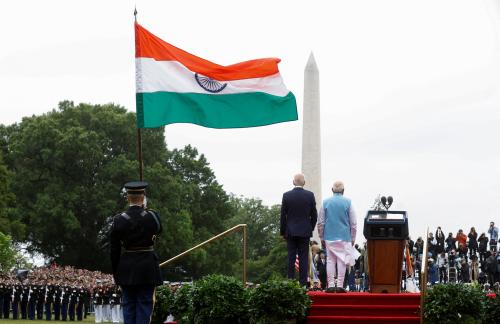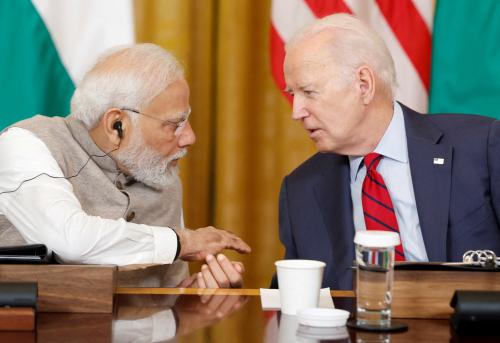By all accounts, like Prime Minister Manmohan Singh, President Barack Obama is keen to strengthen the India-U.S. ties. Sadly, however, recent actions by the United States have only reinforced the feeling on the part of many in India that the president assigns significantly lower priority to India-U.S. relations than did his predecessor, President George W. Bush. This is unfortunate since the U.S. interests in the region align most closely with those of India, at least from a longer-term perspective. Whereas China is already positioning itself as a rival, even belligerent, power and the future of Afghanistan and Pakistan remains highly uncertain, India is a rising democratic power whose national interests are better served by partnership rather than rivalry with the U.S.
Perhaps nothing gave a more negative signal to Indians than the recent decision by the president to play along with protection hawks among Democrats and sign into law an appropriations bill that the Congress recently passed. Using the need for raising revenue to finance enhanced enforcement at the Mexican border as the excuse, the new law raises the fees on certain H-1 B and L-1 temporary-worker visa holders by $2,000 or more. While it is doubtful that the President’s party would make any significant gains in the forthcoming elections from the protectionist rhetoric underlying the new law, the U.S. has already lost considerable goodwill in India on account of it.
Under the Uruguay Round, which brought into existence the WTO and the General Agreement on Trade in Services (GATS), one of the small concessions India had successfully negotiated with the US while agreeing to open its services market to foreign commercial presence was guaranteed access for 65,000 temporary foreign workers to the U.S. market. The new appropriations law, passed with virtually no public discussion or debate, requires the firms employing 50 or more workers and having 50 percent or more of them on the H-1 B visa to pay an extra fee of $2,250 for workers coming to the U.S. under the L-1 intercompany transfer visa and $2,000 for those entering under the H-1 B visa.
Facially, this provision is perhaps consistent with the national treatment commitment made by the U.S. under the Uruguay Round Agreement. This commitment forbids the U.S. from discrimination in favor of U.S. companies with respect to the hiring of temporary workers. Since the new provision applies equally to the U.S. and foreign companies that employ 50 workers of which 50 percent or more are H-1 B visa holders, facially the national treatment commitment is satisfied.
Yet, since India is perhaps the only country whose IT firms satisfy the criterion triggering the higher fee, the law has been seen in India almost uniformly as targeting it. Even substantively, it is questionable whether the national treatment commitment by the U.S. is satisfied. U.S. companies such as the Microsoft, Apple and Oracle that employ talented foreign workers (often educated in the U.S. universities) on H-1 B visas have much easier access to permanent resident visa. They are more easily able to shift their H-1 B workers to this alternative visa and hold the proportion of their foreign H-1 B visa workers well below 50 percent, thus, effectively escaping the law.
In his remarks on the Senate floor prior to the passage of the border security bill, Senator Charles Schumer who sponsored the bill stated, “but recently, some companies have decided to exploit an unintended loophole in the H-1 B visa program to use the program in a manner that many in Congress, including myself, do not believe is consistent with the program’s intent.” His underlying political message is that through the new legislation he intended to close this loophole. If such an objective was indeed achieved and the affected companies dropped their H-1 B employees below the 50 threshold, the legislation’s very basis would come into question!
The purpose of the legislation is to raise revenue. If the companies changed their practice of relying on H-1 B visas for more than 50 percent of the workers, no additional revenue will actually be raised. Therefore, the claim that the law closes some real or imagined loophole in the existing rules is just that. Its real effect is to place Indian companies at a disadvantage and transfer some of their profits to the U.S. Treasury.
As President Obama plans his visit to India, it is important that he recognize the importance of containing measures that have at best small payoff in domestic politics and guaranteed fall out in friendly countries. Indeed, if the promotion of a warm relationship with India is a top priority, he must go a step further and drop the common American practice of insisting on matching concessions for every concession the U.S. offers.
Following the visit to the White House by Prime Minister Manmohan Singh last November, some in the administration had pointed to the failure of India to bring anything to the table as the reason for the lack of substantive progress in India-U.S. relations. This mindset must change. Every concession by the U.S. need not be immediately matched by an equivalent or even bigger concession, especially when the player at the other end happens to be as yet a poor and developing country.
In the ultimate, the payoff from a much stronger friendly democratic India in 10 to 20 years in meeting the geopolitical challenges likely to be posed by the rapid rise of China as a rival power and the adverse developments in Afghanistan and Pakistan far outweighs any unmatched concessions the U.S. might offer in the short term. That, in a nutshell, was the approach George W. Bush took when promoting his nuclear cooperation deal with India.
As a final point, it is must be remembered that the real strength of the relationship will have to flow from business-to-business and person-to-person contacts. The governments can reinforce these contacts by resisting protectionist impulses.



Commentary
Op-edOn Strengthening India-U.S. Ties
September 29, 2010